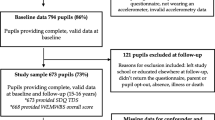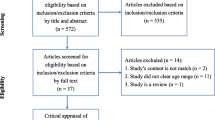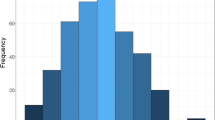Abstract
Socioeconomic inequalities in health are well documented. Recently, researchers have shown interest in exploring the mechanisms by which measures of SES operate through it to impact SRH, such as material, psychosocial and behavioral factors. To examine the relationships between SES indicators and self-rated health (SRH); and to determine whether health behaviors and obesity mediate the association between SES indicators and SRH. A secondary analysis of data previously collected through the third survey of socioeconomic and health status of the Arab population in Israel, in which the SRH of 878 Arab-Israelis age 50 or older were analyzed using logistic regression. The results showed that higher education level and current employment in old age are associated with better SRH. However, neither subjective economic status nor family income was associated with SRH. Greater physical activity was found to be related to good\very good SRH, while obesity was associated with less than good SRH. Finally, health behaviors (physical activity) and obesity were revealed as mediators between SES indicators (education and employment status) and SRH. The results highlight the importance of high education level and employment status in old age to reduce health inequalities. The findings also show that the relationship between SES and SRH can operate through behavioral mechanisms (i.e., physical activity) and their consequences (i.e., obesity), that can, however, be changed in old age.
Similar content being viewed by others
References
Adler, N. E., & Ostrove, J. M. (1999). Socioeconomic status and health: what we know and what we don’t. Annals of the New York Academy of Sciences, 896, 3–15.
Adler, N. E., Boyce, T., Chesney, M. A., Cohen, S., Folkman, S., Kahn, R. L., & Syme, S. L. (1994). Socioeconomic status and health: the challenge of the gradient. American Psychologist, 49(1), 15–24.
Adler, N. E., Epel, E. S., Castellazzo, G., & Ickovics, J. R. (2000). Relationship of subjective and objective social status with psychological and physiological functioning: preliminary data in healthy white women. Health Psychology, 19, 586–592.
Al-Krenawi, A. (2005). Socio-political aspects of mental health practice with Arabs in the Israeli context. Israel Journal of Psychiatry and Related Sciences, 42(2), 126–136.
Alvarez-Galvez, J., Rodero-Cosano, M. L., Motrico, E., Salinas-Perez, J. A., Garcia-Alonso, C., & Salvador-Carulla, L. (2013). The impact of socio-economic status on self-rated health: study of 29 countries using European social surveys (2002–2008). International Journal of Environmental Research and Public Health, 10(3), 747–761. doi:10.3390/ijerph10030747.
Baron-Epel, O., & Kaplan, G. (2009). Can subjective and objective socioeconomic status explain minority health disparities in Israel? Social Science & Medicine, 69, 1460–1467.
Baron-Epel, O., Kaplan, G., Haviv-Messika, A., Tarabeia, J., Green, M. S., & Kaluski, D. N. (2005). Self-reported health as a cultural health determinant in Arab and Jewish Israelis: MABAT— National Health and nutrition survey 1999–2001. Social Science & Medicine, 61, 1256–1266.
Cairney, J. (2000). Socio-economic status and self-rated health among older Canadians. Canadian Journal on Aging, 19(4), 456–478.
Case, A., & Paxson, C. (2005). Sex differences in morbidity and mortality. Demography, 42(2), 189–214.
Chernichovsky, D., & Anson, J. (2005). The Jewish-Arab divide in life expectancy in Israel. Economics and Human Biology, 3, 123–137.
Cott, C. A., Gignac, A. M., & Badley, E. M. (1999). Determinants of self-rated health for Canadians with chronic disease and disability. Journal of Epidemiology & Community Health, 53, 731–736.
Cowell, A. J. (2006). The relationship between education and health behavior: some empirical evidence. Health Economics, 15(2), 125–146.
Daoud, N., Soskolne, V., & Manor, O. (2009a). Educational inequalities in self-rated health within the Arab minority in Israel: explanatory factors. European Journal of Public Health, 19(5), 477–483.
Daoud, N., Soskolne, V., & Manor, O. (2009b). Examining cultural, psychosocial, community and behavioural factors in relationship to socioeconomic inequalities in limiting longstanding illness among the Arab minority in Israel. Journal of Epidemiology and Community Health, 63(5), 351–358.
Darviri, C., Fouka, G., Gnardellis, C., Artemiadis, A. K., Tigani, X., & Alexopoulos, A. C. (2012). Determinants of self-rated health in a representative sample of a rural population: a cross-sectional study in Greece. International Journal of Environmental Research and Public Health, 9, 943–954.
Dowd, J. B., & Zajacova, A. (2007). Does the predictive power of self-rated health for subsequent mortality risk vary by socioeconomic status in the US? International Journal of Epidemiology, 36, 1214–1221.
Dubikaytis, T., Harkanen, T., Regushevskaya, E., Hemminki, E., Haavio-Mannila, E., Laanpere, M., Kuznetsova, O., & Koskinen, S. (2014). Socioeconomic differences in self-rated health among women: a comparison of St. Petersburg to Estonia and Finland. International Journal for Equity in Health, 13. doi:10.1186/1475-9276-13-39.
Endevelt, R., Baron-Epel, O., Karpati, T., & Heymann, A. D. (2009). Does Low Socioeconomic Status Affect Use of Nutritional Services by Pre-Diabetes Patients? International Journal of Health Care Quality Assurance, 22(2), 157–167.
Foraker, R. E., Rose, K. M., Chang, P. P., McNeill, A. M., Suchindran, C. M., Selvin, E., & Rosamond, W. D. (2011). Socioeconomic status and the trajectory of self-rated health. Age and Aging, 40(6), 706–711. doi:10.1093/ageing/afr069.
Ford, J., Spallek, M., & Dobson, A. (2008). Self-rated health and a healthy lifestyle are the most important predictors of survival in elderly women. Age & Aging, 37, 194–200.
Guimaraes, J. M. N., Werneck, G. L., Faerstein, E., Lopes, C. S., & Chor, D. (2014). Early socioeconomic position and self-rated health among civil servants in Brazil: a cross-sectional analysis from the Pró-Saúde cohort study. BMJ, 4, e005321. doi:10.1136/bmjopen-2014-005321.
Hagan, D. E., & Collier, C. M. (1983). Must respondent selection procedures for telephone surveys be invasive? Public Opinion Quarterly, 47(4), 547–556.
Hu, P., Adler, N. E., Goldman, N., Weinstein, M., & Seeman, T. E. (2005). Relationship between subjective social status and measures of health in older Taiwanese persons. Journal of the American Geriatrics Society, 53, 483–488.
Idler, E. L., & Benyamini, Y. (1997). Self rated health and mortality: a review oe twenty-seven community studies. Journal of Health and Social Behavior, 38, 21–37.
Israel Central Bureau of Statistics. (2011). “Israel statistical book “. Jerusalem: State of Israel. [In Hebrew]
Kaleta, D., Makowiec-Dabrowska, T., & Jegier, A. (2008). Employment status and self rated health. International Journal of Occupational and Environmental Health, 21(3), 227–236. doi:10.2478/v10001-008-0023-y.
Khalaila, R., & Litwin, H. (2014). Changes in health behaviors and their associations with depressive symptoms among Israelis aged 50 + . Journal of Aging and Health, 26(3):401–421. doi: 10.1177/0898264313516997.
Komar, M., Nagymajtenyi, L., Nyari, T., & Paulik, E. (2012). The determinants of self-rated health among ethnic minorities in Hungary. Ethnicity & Health, 11, 121–132.
Krieger, N., Williams, D. R., & Moss, N. E. (1997). Measuring social class in US public health research: concepts, methodologies, and guidelines. Annual Review of Public Health, 341–378.
Kull, M., Matsi, J., & Raudsepp, L. (2010). Relationship between various physical activity domains and self perceived health and obesity in women. Women & Health, 50, 639–651.
Lantz, P. M., House, J. S., Lepkowski, J. M., Williams, D. R., Mero, R. P., & Chen, J. (1998). Socioeconomic factors, health behaviors, and mortality. JAMA, 279, 1703–1708.
Leveille, S. G., Zhang, Y., McMullen, W., Kelly-Hayes, M., & Felson, D. T. (2005). (2005). Sex differences in musculoskeletal pain in older adults. Pain, 116, 332–338.
Lim, W.Y., Ma, S., Heng, D., Bhalla, V., & Chew, S.K. (2007). Gender, ethnicity, health behavior & self-rated health in Singapore. BMC Public Health, 7. doi:10.1186/1471-2458/184.
Luo, J., Qu, Z., Rockett, L., & Zhang, X. (2010). Employment status and self rated health in North-Western China. Public Health, 124, 174–179.
Lynch, J. W., Davey, S. G., Kaplan, G. A., & House, J. S. (2000). Income inequality and mortality: importance to health of individual income, psychosocial environment, or material conditions. BMJ, 320, 1200–1204. doi:10.1136/bmj.320.7243.1200.
Mackenbach, J. P., Stirbu, I., Roskam, A. R., Schaap, M. M., Menvielle, G., Leinsalu, M., & Kunst, A. E. (2008). Socioeconomic inequalities in health in 22 European countries. The New England Journal of Medicine, 358, 2468–2481. doi:10.1056/NEJMsa0707519.
Marmot, M., & Wilkinson, R. G. (2001). Income and health: material and psychosocial pathways. A reply to Lynch et al. BMJ, 322, 1233–1236. doi:10.1136/bmj.322.7296.1233.
Matheson, E. M., King, D. E., & Everett, C. J. (2012). Healthy lifestyle habits and mortality in overweight and obese individuals. Journal of the American Board of Family Medicine, 25, 9–15.
McDonough, P., Duncan, G. J., Williams, D., & House, J. (1997). Income dynamics and adult mortality in the United States, 1972 through 1989. American Journal of Public Health, 87(9), 1476–1483.
Mirowsky, J., & Hu, P. N. (1996). Physical impairment and the diminishing effects of income. Social Forces, 74(3), 1073–1096.
Molarius, A., Berglund, K., Eriksson, C., Lambe, M., Nordstrom, E., Eriksson, H. G., & Feldman, I. (2007). Socioeconomic conditions, lifestyle factors, and self –rated health among men and women in Sweden. European Journal of Public Health, 17, 125–133.
Na’amnih, W., Muhsen, K., Tarabeia, J., Saabneh, A., & Green, M. S. (2010). Trends in the gap in life expectancy between Arabs and Jews in Israel between 1975 and 2004. International Journal of Epidemiology, 39, 1324–1332.
Nummela, O. P., Sulander, T. T., Heinonen, H. S., & Uutela, A. K. (2007). Self rated health and indicators of SES among the ageing in the three types of communities. Scandinavian Journal of Public Health, 35, 39–47.
Okosun, I. S., Choi, S., Matamoros, T., & Dever, A. (2001). Obesity is associated with reduced self-rated general health status: evidence from a representative sample of white, black, and Hispanic Americans. Preventive Medicine, 32, 429–436.
Okun, B. S., & Friedlander, D. (2005). Educational stratification among Arabs and Jews in Israel: historical disadvantage, discrimination, and opportunity. POpulation Studies-a Journal of Demography, 59(2), 163–180.
Ostrove, J. M., Adler, N. E., Kuppermann, M., & Washington, A. E. (2000). Objective and subjective assessments of socioeconomic status and their relationship to self-rated health in an ethnically diverse sample of pregnant women. Health Psychology, 19, 613–618.
Pampel, F. C., Krueger, P. M., & Denney, J. T. (2010). Socioeconomic disparities in health behaviors. Annual Review of Sociology, 36, 349–370.
Parks, S.E., Housemann, R.A., & Brownson, R.C. (2003). Differential correlates of physical activity in urban and rural adults of various socioeconomic backgrounds in the United States. Journal of Epidemiology and Community Health, 57, 29–35.
Phillips, L.J., Hammock, R.., & Blanton, J.M. (2005). Predictors of self-rated health status among Texas residents. Preventing Chronic Disease, 2(4). http://www.cdc.gov/pcd/issues/2005/oct/04_0147.htm
Reeves, M. J., & Rafferty, A. P. (2005). Healthy lifestyle characteristics among adults in the US. Archives of Internal Medicine, 165, 854–857.
Rouhana, N., & Ghanem, A. (1998). The crisis of minorities in ethnic states: the case of Palestinian citizens in Israel. International Journal of Middle East Studies, 30(3), 321–346.
Sargent-Cox, K., Cherbuin, N., Morris, L., Butterworth, P., & Anstey, K. J. (2014). The effect of health behavior change on self rated health across the adult life course: a longitudinal cohort study. Preventive Medicine, 58, 75–80.
Selivanova, A., & Cramm, J. M. (2014). The relationship between healthy behaviors and health outcomes among older adults in Russia. BMC Public Health, 14. doi:10.1186/1471-2458-14-1183.
Shavers, V. L. (2007). Measurement of socioeconomic status in health disparities research. Journal of the National Medical Association, 99, 1013–1023.
Shaw, B. A., & Spokane, L. S. (2008). Examining the association between education level and physical activity changes during early old age. Aging Health, 20(7), 767–787. doi:10.1177/0898264308321081.
Sheikh Muhammad, A., & Khatib, M. (2011).The Palestinians in Israel third socio-economic survey, 2010. Design and production: Dar al-Arkan Publishing Ltd (In Arabic). http://www.gal-soc.org/article/20/Socio-economic-survey
Shields, M., & Shooshtari, S. (2001). Determinants of self –perceived health. Health Reports, 13, 35–52.
Sulander, T., Pohjolainen, P., & Karvinen, E. (2012). Self-rated health (SRH) and socioeconomic position (SEP) among urban home-dwelling older adults. Archives of Gerontology and Geriatrics, 54, 117–120.
Sun, W., Watanabe, M., Tanimoto, Y., Shibutani, T., Kono, R., Saito, M., … Kono, K. (2007). Factors associated with good self-rated health of non –disabled elderly living alone in Japan: a cross-sectional study. BMC Public Health, 7.doi:10.1186/1471-2458-7-297
Author information
Authors and Affiliations
Corresponding author
Rights and permissions
About this article
Cite this article
Khalaila, R.N.R. Socioeconomic Status, Health Behaviors, Obesity and Self-Rated Health among Older Arabs in Israel. J Cross Cult Gerontol 32, 115–130 (2017). https://doi.org/10.1007/s10823-016-9301-5
Published:
Issue Date:
DOI: https://doi.org/10.1007/s10823-016-9301-5




